The Intel Core i7-8086K Review
by Ian Cutress on June 11, 2018 8:00 AM EST- Posted in
- CPUs
- Intel
- Core i7
- Anniversary
- Coffee Lake
- i7-8086K
- 5 GHz
- 8086K
- 5.0 GHz
Benchmarking Performance: CPU Rendering Tests
Rendering tests are a long-time favorite of reviewers and benchmarkers, as the code used by rendering packages is usually highly optimized to squeeze every little bit of performance out. Sometimes rendering programs end up being heavily memory dependent as well - when you have that many threads flying about with a ton of data, having low latency memory can be key to everything. Here we take a few of the usual rendering packages under Windows 10, as well as a few new interesting benchmarks.
All of our benchmark results can also be found in our benchmark engine, Bench.
Corona 1.3: link
Corona is a standalone package designed to assist software like 3ds Max and Maya with photorealism via ray tracing. It's simple - shoot rays, get pixels. OK, it's more complicated than that, but the benchmark renders a fixed scene six times and offers results in terms of time and rays per second. The official benchmark tables list user submitted results in terms of time, however I feel rays per second is a better metric (in general, scores where higher is better seem to be easier to explain anyway). Corona likes to pile on the threads, so the results end up being very staggered based on thread count.

Corona is a fully multi-threaded test, so it is surprising to see the 8086K lag behind the 8700K here. This is likely a scenario where the fact that our borrowed testbed setup doesn't perfectly match our standard testbed is playing a factor.
Blender 2.78: link
For a render that has been around for what seems like ages, Blender is still a highly popular tool. We managed to wrap up a standard workload into the February 5 nightly build of Blender and measure the time it takes to render the first frame of the scene. Being one of the bigger open source tools out there, it means both AMD and Intel work actively to help improve the codebase, for better or for worse on their own/each other's microarchitecture.
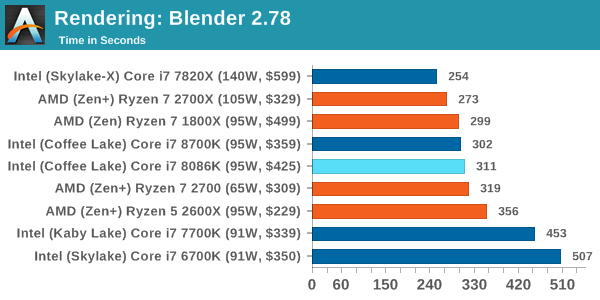
Blender also likes to load up the threads, and the 8086K is behind again.
LuxMark v3.1: Link
As a synthetic, LuxMark might come across as somewhat arbitrary as a renderer, given that it's mainly used to test GPUs, but it does offer both an OpenCL and a standard C++ mode. In this instance, aside from seeing the comparison in each coding mode for cores and IPC, we also get to see the difference in performance moving from a C++ based code-stack to an OpenCL one with a CPU as the main host.
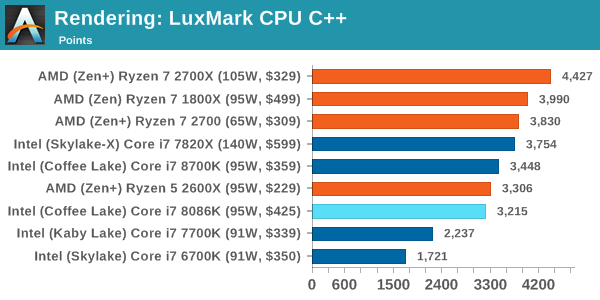

POV-Ray 3.7.1b4
Another regular benchmark in most suites, POV-Ray is another ray-tracer but has been around for many years. It just so happens that during the run up to AMD's Ryzen launch, the code base started to get active again with developers making changes to the code and pushing out updates. Our version and benchmarking started just before that was happening, but given time we will see where the POV-Ray code ends up and adjust in due course.
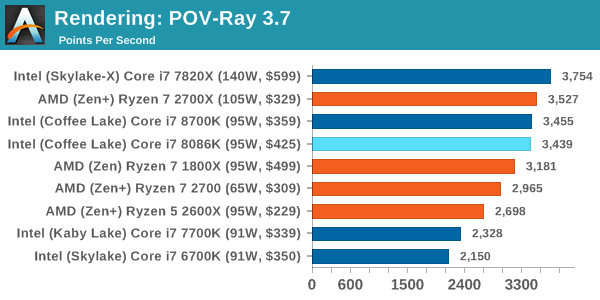
Virtually identical scores between the 8086K and 8700K in POV-Ray.
Cinebench R15: link
The latest version of CineBench has also become one of those 'used everywhere' benchmarks, particularly as an indicator of single thread performance. High IPC and high frequency gives performance in ST, whereas having good scaling and many cores is where the MT test wins out.
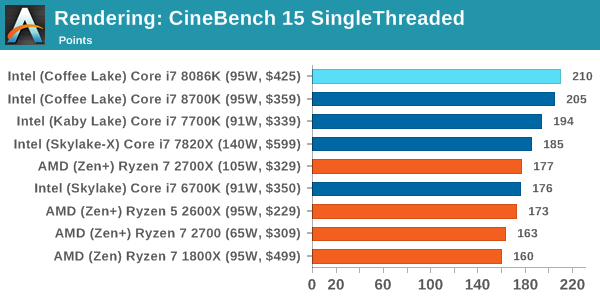
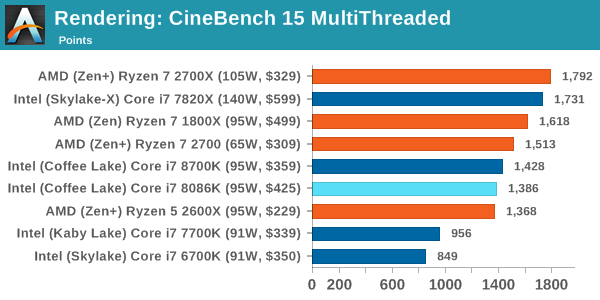
The 8086K gets a new fastest single core score in CineBench R15 ST, but falls slightly behind the 8700K in MT.










111 Comments
View All Comments
ipkh - Monday, June 11, 2018 - link
The multiplier chart doesn't make sense.The single core is 5Ghz, but Intel is quoting 4.7 Ghz all core and you're showing 4.4 identical to 8700K. I understand the base frequencies are the same, but the default multiplier for the 8086K should be higher. Is this a possible bios glitch or is the multiplier chart in the CPU not correct?
Hxx - Monday, June 11, 2018 - link
Boost frequencies are all the same on 5 cores. there is a youtube video with somebody testing this chip on a z370 gaming 7 and you can clearly see in that video that boost is the same on all cores except 1. Intel = lame.Ian Cutress - Monday, June 11, 2018 - link
Where is Intel promoting 4.7 GHz all core?HStewart - Monday, June 11, 2018 - link
One thing that is strange is the name - the Original IBM PC that started this whole PC industry used the intel 8088 processor and not the Intel 8086 processor. The difference is that 8088 has 8 bit external and 8086 has 16 bit external - But CPU's used 16 bit internally. No internal Floating processor until the 386 line.But it wild that it been 40 years - I have an original IBM PC - in my downstairs closet, I remember while at Georgia Tech - putting a 2Meg Ram card into and booting up to 1.4Meg ramdisk and loading Microsoft C 3.0 compiler on it.
As for new one - it would be cool if they actually included the original chip also as part of collectors edition.
AsParallel - Monday, June 11, 2018 - link
8088 shipped in 79, was a variant of the 8086. 8086 was the first to 1M transistorspeevee - Monday, June 11, 2018 - link
"No internal Floating processor until the 386 line."486. 386 still used 387 AFAIR. There were even 487, but it was just renamed 486 to be installed with 486SX.
HStewart - Monday, June 11, 2018 - link
Yes I forgot that - the 486 was the one with Math Coprocessor.AsParallel - Monday, June 11, 2018 - link
Addition. The 8087 was the floating point coprocessor for the 8086/8829a - Monday, June 11, 2018 - link
You didn't put 2mb of RAM in an original IBM PC it supported 256kb max.HStewart - Monday, June 11, 2018 - link
I had a special card in the PC - it was EMS memory - that could also fill up the main system memory to 640kb - instead of normal cache mode use by the card - I configured it as ram drive. Memory above 640Kb was directly accessible by the system.